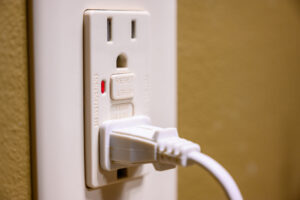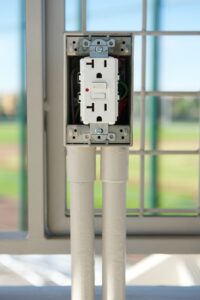 A GFCI outlet, or Ground Fault Circuit Interrupter, is a type of electrical outlet that protects you from electric shock. It monitors the flow of electricity in a circuit and shuts off power instantly if it detects a leak or imbalance in the current. GFCIs are required in areas with moisture, like kitchens, bathrooms, and outdoor spaces.
A GFCI outlet, or Ground Fault Circuit Interrupter, is a type of electrical outlet that protects you from electric shock. It monitors the flow of electricity in a circuit and shuts off power instantly if it detects a leak or imbalance in the current. GFCIs are required in areas with moisture, like kitchens, bathrooms, and outdoor spaces.
This article explains how GFCIs work, where they are needed, how to test them, and when they should be repaired or replaced. We’ll also cover common causes of tripping, types of GFCI devices, and why professional installation matters.
Quick Takeaways
- GFCI outlets help prevent electric shock and electrocution.
- They shut off power in under 1/40th of a second.
- GFCIs are required by code in high-risk areas.
- You can test them using built-in buttons or an outlet tester.
- If a GFCI won’t reset or keeps tripping, it should be replaced.
- Licensed electricians should install, test, and replace GFCIs.
How Does a GFCI Outlet Work?
A GFCI outlet constantly compares the amount of electricity going into a circuit with the amount coming out. If the GFCI detects a difference greater than 4–6 milliamps, it trips the internal breaker and shuts off power.
This shutoff happens in less than a second. The device stops the electricity before it can flow through a person and cause harm. Unlike standard breakers, GFCIs are made to protect people, not just wires. They work silently in the background, cutting power only when something’s wrong.
Where Are GFCI Outlets Required?
The National Electrical Code (NEC) requires GFCI protection in areas where water is present.
These include:
- Kitchens
- Bathrooms
- Garages
- Laundry rooms
- Basements
- Outdoor outlets
- Any outlet within six feet of a sink, tub, or water source
These requirements apply to new builds and renovations. GFCIs reduce the risk of electrical shock in damp or wet areas. Adding them to older homes is often recommended during upgrades or inspections.
Types of GFCI Protection Devices

There are three common types of GFCI protection:
GFCI Receptacles: These are the wall outlets with “TEST” and “RESET” buttons. They protect individual outlets and any others downstream on the same circuit.
GFCI Circuit Breakers: Installed in the electrical panel, these protect all outlets on a given circuit. They replace standard breakers and offer broader coverage, especially for kitchens, laundry rooms, or garages.
Portable GFCIs: Used on job sites or outdoor projects. These plug into regular outlets and offer temporary protection where needed. They’re helpful for tools and appliances in environments where permanent GFCIs aren’t installed.
Each type has benefits. Receptacles are great for isolated upgrades. Circuit breakers cover multiple locations. Portable options are best for temporary or mobile use.
How to Test and Reset a GFCI Outlet
Testing your GFCI ensures it works when it matters.
Here’s how:
- Plug in a small device like a lamp. Make sure it’s on.
- Press the “TEST” button. The lamp should turn off.
- Press the “RESET” button. The lamp should turn back on.
You can also use a plug-in GFCI tester. These confirm power and grounding. If the outlet does not trip or reset, it needs to be replaced.
Test your GFCIs monthly. Also test them after power outages, storms, or if they’ve tripped for unknown reasons. A failed test means the outlet is no longer doing its job.
Signs a GFCI Outlet Is Failing or Needs Replacement
Watch for these signs:
- It won’t reset
- The outlet is warm or buzzing
- Devices lose power intermittently
- It trips for no clear reason
- The test button doesn’t work
- Burn marks or discoloration
If you see any of these, the outlet may no longer provide protection. Replacing it can prevent more serious electrical issues.
Common Causes of GFCI Tripping
A GFCI may trip for several reasons:
- Moisture or water intrusion
- Faulty or worn-out appliances
- Ground faults in the wiring
- Overloaded circuits
- Age or wear inside the GFCI device
Sometimes the fix is simple, dry the outlet or unplug a device. But if the GFCI keeps tripping, it’s best to have it inspected.
Why GFCI Outlets Are Required by Code
 The NEC requires GFCIs in specific locations for safety. These outlets reduce the risk of electric shock and fire in high-risk areas.
The NEC requires GFCIs in specific locations for safety. These outlets reduce the risk of electric shock and fire in high-risk areas.
Homes with GFCIs are safer and often meet insurance or inspection requirements. During remodels or code updates, adding GFCIs is usually required. GFCIs also add value during home sales or inspections.
Can You Install or Replace a GFCI Outlet Yourself?
Yes, if you understand wiring and safety. But mistakes are common. Miswiring a GFCI can leave downstream outlets unprotected or cause nuisance tripping.
Professional electricians ensure safe, code-compliant installations. They also identify whether a receptacle or breaker-style GFCI is better for your home.
Need help in Centennial, CO? Contact us.
GFCI Outlet Installation and Repair in Centennial, CO
 Genesis Electrical provides expert GFCI outlet installation, testing, and replacement in Centennial, CO and surrounding areas. Whether your outlet is tripping or you need to bring your home up to code, our licensed electricians are ready to help.
Genesis Electrical provides expert GFCI outlet installation, testing, and replacement in Centennial, CO and surrounding areas. Whether your outlet is tripping or you need to bring your home up to code, our licensed electricians are ready to help.
Genesis keeps you out of the dark.
FAQs About GFCI Outlets
What does GFCI stand for?
Ground Fault Circuit Interrupter.
Do GFCI outlets go bad over time?
Yes. They usually last 7–10 years and should be tested regularly.
Can a GFCI outlet be used with any device?
Yes, but it may trip with appliances that draw uneven current.
Why does my GFCI keep tripping when it rains?
Moisture in outdoor boxes or wiring can cause tripping. Check for water intrusion.
Can I replace a regular outlet with a GFCI?
Yes, but the GFCI must be wired properly to provide downstream protection.
What’s the difference between a GFCI and an AFCI?
GFCIs protect against shock from ground faults. AFCIs protect against electrical fires from arc faults.
Does a GFCI need a ground?
No. GFCIs work without a ground, but must be labeled “No Equipment Ground.”
Are GFCI outlets required in older homes?
Not always, but adding them improves safety and may be required during upgrades.
Do refrigerators need GFCI?
In some cases, yes. If located in a garage or near water, GFCI protection may be required.